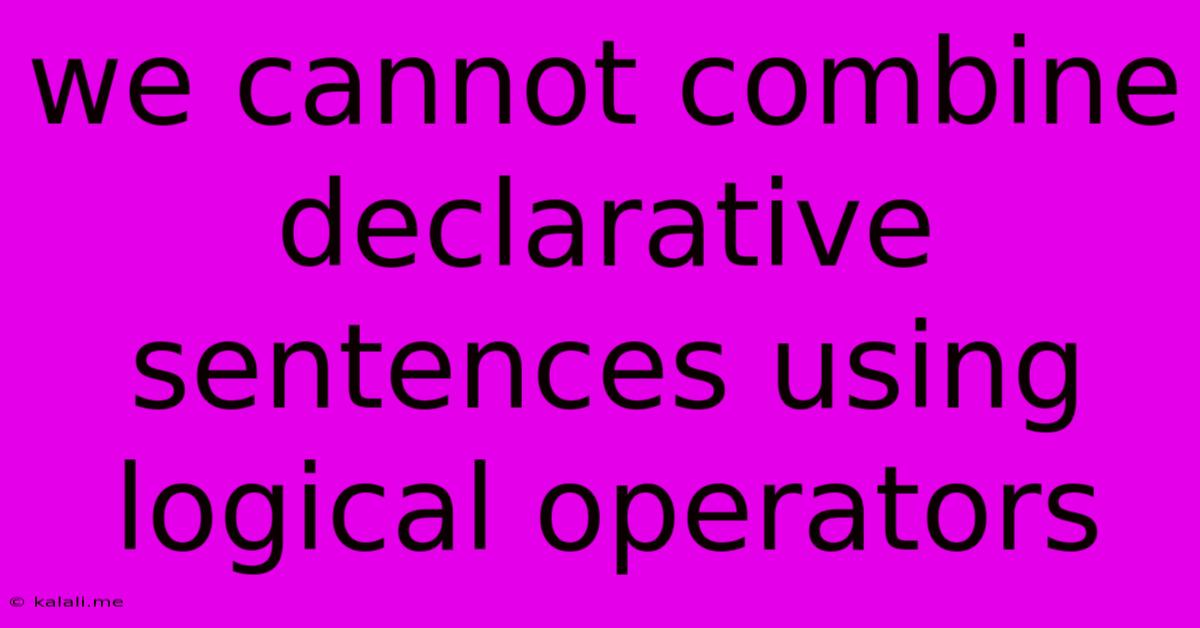We Cannot Combine Declarative Sentences Using Logical Operators
Kalali
May 31, 2025 · 3 min read

Table of Contents
We Can't Combine Declarative Sentences Using Logical Operators: A Deep Dive into Syntax and Semantics
Meta Description: Discover why you can't directly combine declarative sentences with logical operators like "and" or "or." This article explores the grammatical and logical reasons behind this limitation and offers alternative solutions for expressing complex ideas.
Declarative sentences, those straightforward statements that declare facts or opinions, form the backbone of our communication. We use them to convey information, express beliefs, and share our perspectives. But what happens when we want to link multiple declarative statements together to represent a more complex idea? Can we simply use logical operators like "and," "or," and "not" to join them? The short answer is: no, not directly. While the meaning might be clear, the resulting structure isn't grammatically correct. This article will delve into the reasons behind this limitation, exploring the crucial differences between logical propositions and grammatical sentence structures.
The Problem: Logic vs. Grammar
The core issue lies in the fundamental difference between logical propositions and grammatical sentences. Logical operators like "and," "or," and "not" operate on propositions, which are statements that can be either true or false. These propositions are typically stripped down to their essential meaning, devoid of grammatical complexities.
Consider these declarative sentences:
- Sentence A: The sky is blue.
- Sentence B: The grass is green.
In logic, we can combine these as propositions:
- P: The sky is blue.
- Q: The grass is green.
And we can use logical connectives to form compound propositions:
- P ∧ Q (P and Q): The sky is blue and the grass is green.
However, directly connecting the original sentences "The sky is blue and the grass is green" doesn't create a single grammatical sentence. The conjunction "and" connects propositions, not complete grammatical clauses.
Why the Direct Combination Fails
Grammatically, a conjunction like "and" needs to join elements of equal grammatical rank. In the case of complete sentences, this usually requires a semicolon or a period, creating separate but related sentences. Using "and" alone creates a run-on sentence or a comma splice, both grammatical errors.
Let's look at correct ways to combine these ideas:
Correct Ways to Combine Declarative Sentences
Here are several grammatically correct methods to express the combined meaning of the sentences:
-
Using a semicolon: "The sky is blue; the grass is green." This effectively connects two independent clauses.
-
Using a coordinating conjunction with a comma: "The sky is blue, and the grass is green." This uses the conjunction appropriately to join two independent clauses.
-
Using a subordinating conjunction: "Because the sky is blue, the grass appears greener." Here, one clause modifies the other.
-
Creating a single compound sentence with a conjunction: "The sky is blue and the grass is green, creating a vibrant landscape." This method incorporates both facts into a single, more complex sentence while maintaining grammatical correctness.
Beyond "And": Other Logical Operators
The issues extend beyond "and." Other logical operators like "or" and "not" also require careful grammatical handling. You can't simply say, "The sky is blue or the grass is green," unless it's part of a larger, grammatically correct sentence.
The key is to understand that logical operators operate on the meaning of the statements, while grammatical structures dictate how these statements are expressed in a coherent and grammatically acceptable way.
Conclusion: Meaning and Structure
While logical operators provide a powerful tool for analyzing and combining ideas, directly applying them to combine declarative sentences creates grammatically incorrect structures. The art lies in translating the logical structure into grammatically correct and stylistically appealing prose. Remember to focus on the grammatical rules that guide the structure of your writing while expressing the desired logical relationships between your ideas. By using the right punctuation and conjunctions, you can effortlessly combine multiple declarative sentences to communicate complex ideas clearly and effectively.
Latest Posts
Latest Posts
-
Coming Down The Pike Or Coming Down The Pipe
Jun 02, 2025
-
When Is 90 More Than 100
Jun 02, 2025
-
How To Tell If Function Is One To One Precalculus
Jun 02, 2025
-
How To Connect Joist To Beam
Jun 02, 2025
-
The Prophecy Of The Chosen One The Jedi Path
Jun 02, 2025
Related Post
Thank you for visiting our website which covers about We Cannot Combine Declarative Sentences Using Logical Operators . We hope the information provided has been useful to you. Feel free to contact us if you have any questions or need further assistance. See you next time and don't miss to bookmark.